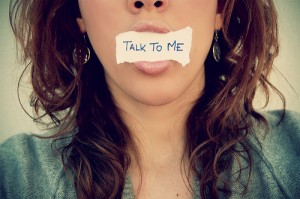Storytelling and Social Engagement
Prepare for a reactive post, no, an interactive conversation, about social engagement.
But first, what about that photo? Bam! A powerful graphic. Except for the middle word…
I’d prefer “Talk with me.” Because social media is all about with. Old school, top-down, one-way, pump-it-out, force fed broadcast media was all about to. Do you follow me?
Engaging Storytelling
Media has evolved. Most of it. Not all. There are still a few knuckle-draggers lurking in the shadows!
Which is why storytelling – in it’s simplest, purest and most engaging form – trumps old school broadcast media. Storytelling in its oldest form. Pre-books. Pre-TV. Pre-movies.
Storytelling is about social engagement, author-audience engagement. Storytelling is about relationships. It’s about with. Not to.
Social Media
Which brings me to Randy Thio (@ideabloke), the founder of ideabloke, “a personal digital media agency committed to 100% organic social media practices.” His post, The Endgame Of Social Engagement provoked my curiosity because I don’t consider social media to have an endgame. Not in the conventional sense. At best there’s no final stage. No end of the process.
Social media is about building relationships, about engaging and maintaining communication, about interacting, about author and audience evolving together.
Social Engagement
But Thio is focusing on the initial social engagement, not social media in general. The objective of engaging an individual through social media, he proposes, is to provoke (and then hopefully extend) a response.
In it’s purest sense, engagement is the ability to cause another person to respond… using any (or a combination of) the following methods:
- Comments – In response to a status update, tweet, or blog post.
- Shares – Includes linking/mentioning on a blog post they wrote.
- Likes – Includes +K’s, Kred, etc.
- Retweets – Whether native or via a tweet button
- Mentions – Includes Follow Fridays, etc.
- Favorites – Anytime your tweet/update/post is faved on any platform
- Pins/Repins – Pinterest specific of course.
- Tags – Whenever a user is tagged on pics on any platform.
- Hashtags – When ppl begin to adopt & share a hashtag you created.
- Pokes – Yes, I did just put that on there.
Whichever method the audience chooses to respond, it’s critical to acknowledge and capitalize on the opportunity to have a conversation… geared to get to know that particular person… which hopefully leads to a relationship. ~ Randy Thio (ideabloke.com)
Social Media as Storytelling
Short of wandering village to village like Mario Vargas Llosa’s storyteller, social media offers raconteurs of all stripes ideal audience interaction. Ideal global audience interaction. With no end game. Except building a rich and enduring relationship. Social engagement is the first step, the wink, the handshake of social media. Social engagement is the open door behind the well worn welcome mat.
Unlike broadcasters, live storytellers understand this intuitively. Initial social engagement is the spark of interest, the pause long enough to listen, a provocation, an invitation. But storytelling itself, live storytelling, is the original social media. Live storytelling is an interactive relationship, and the story evolves accordingly, being shaped collaboratively by author and audience. The storyteller listens and watches and feels, tailoring the narrative to the appetites and needs of the audience. Sometimes abbreviating; other times inventing extemporaneously.


 The Peruvian writer
The Peruvian writer 

